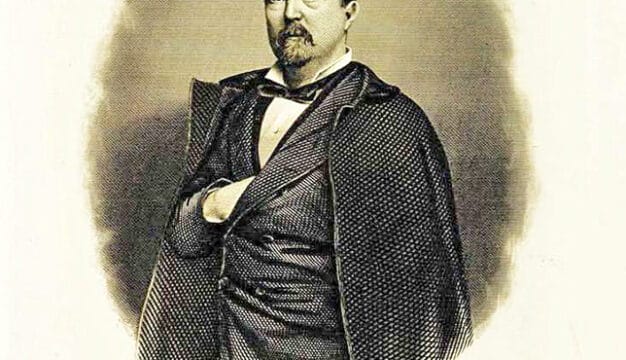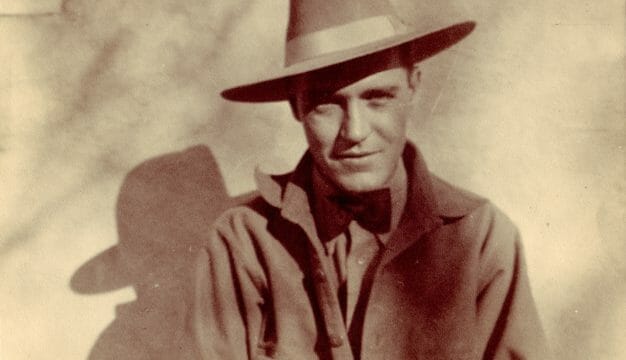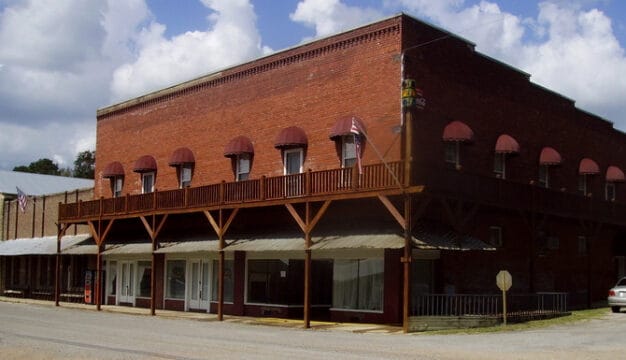Brown Chapel AME Church
The Brown Chapel African Methodist Episcopal (AME) church is a historic African American church in Selma, Dallas County. The chapel itself and members of the congregations played a pivotal role in the civil rights movement and the March 1965 marches from Selma to Montgomery that helped bring attention to the movement and also prompt passage of the Voting Rights Act of 1965. The chapel is named for AME bishop John Mifflin Brown, an African American born in Delaware who established the AME church at the Selma chapel. Brown Chapel was added to the Alabama Register of Landmarks and Heritage on June 16, 1976, added to the National Register of Historic Places in 1982, and declared a National Historic Landmark in 1997.
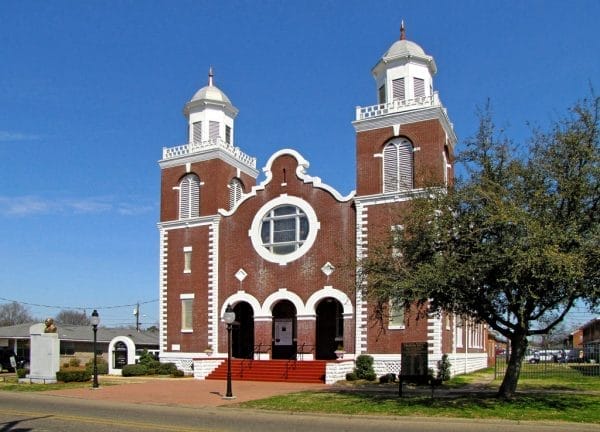 Brown Chapel A.M.E. Church in Selma
Enslaved people in Selma originally attended church with whites at what federal records refer to as First Methodist Episcopal Church. (Present-day Church Street Methodist dates from the 1830s and one local history notes that enslaved peoples attended that church with their masters.) After the Union victory in the Civil War and ensuing emancipation of the enslaved, the black congregation moved to the basement of the Broad Street (later Albert) Hotel in 1866; the basement acted as the Colored AME Church of the South with both a Sunday school and a mission. The congregation was admitted to the African Methodist Episcopal Church in 1867 and Bishop Brown held the first Alabama Conference for the AME Church in 1868. The site where the chapel stands today first had a frame structure constructed there in 1869, and the present building dates to 1908. The chapel was constructed by African American builder A. J. Farley, who was born in nearby Beloit, Dallas County.
Brown Chapel A.M.E. Church in Selma
Enslaved people in Selma originally attended church with whites at what federal records refer to as First Methodist Episcopal Church. (Present-day Church Street Methodist dates from the 1830s and one local history notes that enslaved peoples attended that church with their masters.) After the Union victory in the Civil War and ensuing emancipation of the enslaved, the black congregation moved to the basement of the Broad Street (later Albert) Hotel in 1866; the basement acted as the Colored AME Church of the South with both a Sunday school and a mission. The congregation was admitted to the African Methodist Episcopal Church in 1867 and Bishop Brown held the first Alabama Conference for the AME Church in 1868. The site where the chapel stands today first had a frame structure constructed there in 1869, and the present building dates to 1908. The chapel was constructed by African American builder A. J. Farley, who was born in nearby Beloit, Dallas County.
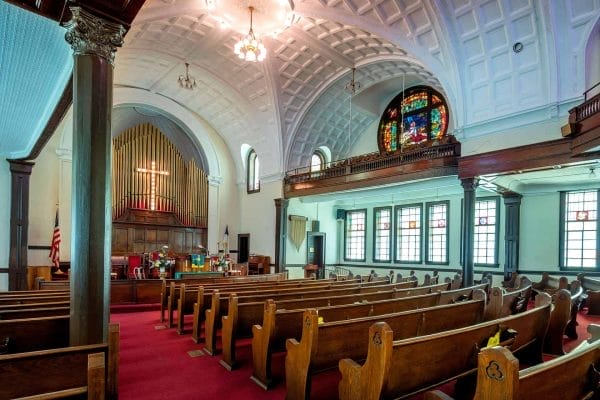 Brown Chapel Interior
Brown Chapel is a Romanesque Revival-style building. The roof has two intersecting gables and parapet gabled ends. It features twin square towers with wooden staircases and baluster railings in the interior. The towers flank a recessed triple stone arched portico and a nave at the front façade. The walls are a dark red stretcher-bond brick. Located over the portico at the entrance of the chapel there is a large stained glass rose window with two horizontal and two vertical mullions that divide the window into nine panes. The interior features three balconies and vaults supported by wooden Ionic columns and two Ionic pilasters each supporting a proscenium arch that holds the pipes for the organ. There are coffered ceilings with intersecting ribbed barrel vaults and five chandeliers hanging from the ceiling. In 1967, several one-story buildings were added behind the chapel, including a kitchen, an education room, an office, an all-purpose room, and restrooms.
Brown Chapel Interior
Brown Chapel is a Romanesque Revival-style building. The roof has two intersecting gables and parapet gabled ends. It features twin square towers with wooden staircases and baluster railings in the interior. The towers flank a recessed triple stone arched portico and a nave at the front façade. The walls are a dark red stretcher-bond brick. Located over the portico at the entrance of the chapel there is a large stained glass rose window with two horizontal and two vertical mullions that divide the window into nine panes. The interior features three balconies and vaults supported by wooden Ionic columns and two Ionic pilasters each supporting a proscenium arch that holds the pipes for the organ. There are coffered ceilings with intersecting ribbed barrel vaults and five chandeliers hanging from the ceiling. In 1967, several one-story buildings were added behind the chapel, including a kitchen, an education room, an office, an all-purpose room, and restrooms.
Brown Chapel came to national prominence during the civil rights movement, in the mid-1960s when Selma became a focal point for voting rights activists like Martin Luther King Jr. and Ralph Abernathy of the Southern Christian Leadership Conference (SCLC) and John Lewis of the Student Nonviolent Coordinating Committee. The chapel remained open and provided shelter despite both state and federal injunctions prohibiting mass meetings in black churches. It also hosted meetings of the SCLC in the first months of 1965 and speeches by Martin Luther King Jr. on January 2 and Malcolm X of the Nation of Islam on February 4. Most notably, the chapel was the starting point for the Selma to Montgomery marches in March 1965.
Fewer than five months after the marches, Pres. Lyndon B. Johnson signed the 1965 Voting Rights Act. Though he had been considering a Voting Rights Act since 1964, the events of “Bloody Sunday,” the violence the protesters faced as and the symbolic marches led by King afterwards are credited with drawing national attention to the issue of voting discrimination and prompting quick passage of the law.
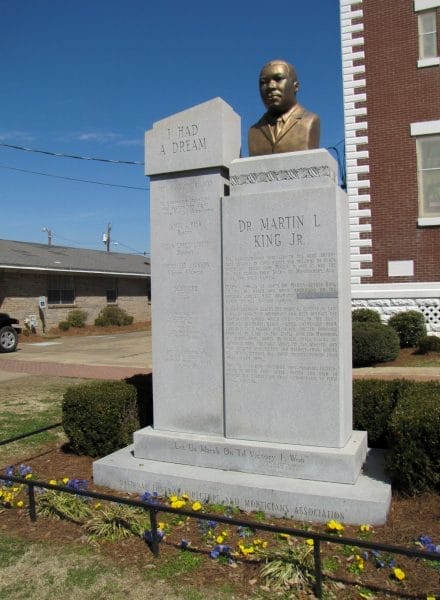 King Monument in Selma
In August 1979, a granite monument to the Selma to Montgomery march was dedicated in front of the chapel. It features a bust of Martin Luther King Jr. and also lists James Reeb, Viola Gregg Liuzzo, and Jimmie Lee Jackson, who gave their lives during the movement. The Civil Rights Freedom Wall, a black marble memorial erected in 2005 on the other side of the church, lists the names of individuals involved in the struggle from 1950 to 2000. The church is still active today.
King Monument in Selma
In August 1979, a granite monument to the Selma to Montgomery march was dedicated in front of the chapel. It features a bust of Martin Luther King Jr. and also lists James Reeb, Viola Gregg Liuzzo, and Jimmie Lee Jackson, who gave their lives during the movement. The Civil Rights Freedom Wall, a black marble memorial erected in 2005 on the other side of the church, lists the names of individuals involved in the struggle from 1950 to 2000. The church is still active today.
Brown Chapel AME Church is located at 410 Martin Luther King Street and visiting hours are by appointment Monday to Friday 10:00-12:00 and 2:00-4:00. It is the starting point of the Selma to Montgomery National Historic Trail, which leads from Selma to the State Capitol building in Montgomery, Montgomery County, the end point of the March 25, 1965, march. Nearby are the First Baptist Church of Selma, the Selma Interpretive Center, the Ancient Africa, Enslavement, and Civil War Museum, the Old Depot Museum, the National Voting Rights Museum, and Sturdivant Hall Museum.
Further Reading
- Collins, Donald E. When the Church Bell Rang Racist: The Methodist Church and the Civil Rights Movement in Alabama. Macon, Ga.: Mercer University Press, 1998.
- Fitts, Alston, III. Selma: A Bicentennial History. Tuscaloosa: University of Alabama Press, 2016.
- Thornton, J. Mills. Dividing Lines: Municipal Politics and the Struggle for Civil Rights in Montgomery, Birmingham, and Selma. Tuscaloosa: University of Alabama Press, 2002.

